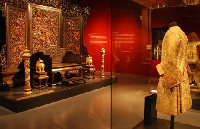Palace Museum outlines its steps to preserve site
By Wang Kaihao ( chinadaily.com.cn )
Updated: 2014-05-16
Lu Qiong, deputy head of the office in charge of World Cultural Heritage protection under the State Administration of Cultural Heritage, said systematic monitoring has been launched in 13 of the total 45 World Heritage Sites in China, after a national center in charge of monitoring these sites was established in 2011.
|
|
China has the world's second-largest number of World Heritage Sites after Italy.
"What the Palace Museum is doing has given many new ideas. … We expect to see more content on monitoring the buffer zone around the site in the next annual report," Lu said.
Shan admitted that supervision over the surrounding 14-square-km buffer zone around the Palace Museum is crucial, but the huge number of nearby residents and complicated circumstances in this Beijing's busy downtown area make it a difficult job, and it expects more cooperation from the public and Beijing government.
Chen Tongbin, vice-president of the Committee of Traditional Architecture and Landscape, under the Archeological Society of China, said: "A common problem in today's monitoring is that we lack a warning system and clear criteria for when to take actions after dangerous situations for these sites are detected."
"That needs more than establishment of monitoring devices, but a more detailed plan for future work," Chen said.
"If the Palace Museum sets a good example, it will help our candidates bidding for World Heritage Sites," Chen added.



